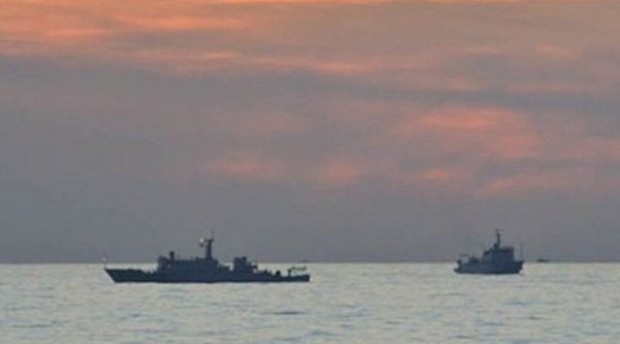
This undated handout photo taken by the Philippine Navy and released April 11, 2012, by the Department of Foreign Affairs shows Chinese surveillance ships off Panatag (Scarborough) Shoal. Armed Forces Chief of Staff Gen. Emmanuel Bautista on Monday, Feb. 24, 2014, accused China’s Coast Guard of firing water cannon at Filipino fishermen to drive them away from Panatag Shoal in the West Philippine Sea. AFP FILE PHOTO/DFA/PN
MASINLOC, Zambales—Foreign journalists on Saturday documented firsthand accounts of Filipino fishermen who operate near the disputed Bajo de Masinloc, also known as the Scarborough or Panatag Shoal, in the West Philippine Sea.
“It felt like we were up against a Chinese warship,” said fisherman Viany Mula, 43, who narrated his experience of aggression by the Chinese Coast Guard patrolling the shoal. He was among the fishermen who were driven away by the water cannons fired by the Chinese in January last year.
Really scared
Mula talked with 15 journalists, who are fellows under the Hawaii-based East-West Center’s (EWC) Jefferson fellowship program and are here to study territorial disputes.
“We were really scared when they fired water at us. We just wanted to fish in that area,” said Mula, a fishing boat captain who was with a fleet of Filipino fishermen at that time when bad weather forced them to take refuge at the shoal. Suddenly, he said, they were assaulted with water cannons by a Chinese Coast Guard vessel.
Aside from China’s sea patrols there, a Chinese helicopter drove the fishermen away in April 2013, said Macario Forones, 56, owner of several boats that were sprayed with water by the Chinese vessels. The helicopter, he said, chased them up to 16 kilometers.
Forones said his crew had been fishing near the shoal for more than a decade now. The aggression of Chinese near the shoal was first experienced by local fishermen in 2011, he said.
“The last time I sailed near the shoal was on April 6, 2013. We were again driven away by the Chinese Coast Guard. I have not returned since then,” Forones said.
Harvesting clams, corals
Another fisherman, Peter Manglicmot, 40, said the Chinese Coast Guard personnel had been harvesting giant clams and collecting corals from the waters near the shoal.
Zambales Gov. Hermogenes Ebdane Jr. said some 2,400 fishing families in his province had been experiencing the impact of the ongoing dispute at Bajo de Masinloc.
“While our eyes are glued on [the heated exchanges between the Philippine and Chinese governments], we lose sight of the everyday situation within and along our territorial waters,” Ebdane said at a dialogue with the foreign journalists.
He said local fishermen had become apprehensive about the territorial dispute “affecting not only their means of living, but also the welfare of their respective families.”
Ebdane said he was hoping that the international media “would highlight the day-to-day plight of our voiceless fishermen.”
Provides assistance
He said the provincial government has been assisting the fishermen and their families by providing fishing devices such as boat engines, life vests, gill nets and “payaw” (artificial reef).
Masinloc Mayor Desiree Edora said residents were “disturbed socially, culturally and economically” by the presence of the Chinese in the shoal, which is 230 km from Masinloc town.
“We cry for justice for the good of the Filipino community. We need to fight for our sovereignty and let the Philippines be Philippines for all Filipino people,” Edora said.
Fresh insights
One of the foreign journalists, Dr. Rungthip Chotnapalai, news anchor of Bangkok-based Thai Television Channel 3, said the journalists’ visit had allowed her to get fresh insights from local fishermen directly affected by the territorial disputes.
“We’ve learned so much about the condition of the fishermen. I’ll be reporting about this when I go back to Thailand so our viewers will be aware of this issue,” she told the Inquirer.
Ann Hartman, EWC Jefferson fellowship program coordinator, said the journalists were traveling together to study “crucial South China Sea (West Philippine Sea) issues.”
The 15 delegates represent various news organizations worldwide, said Dr. Gerard Finin, EWC Pacific Islands Development Program director. They include journalists from Australian Broadcasting Corp., Kyodo News, The Times of India, The Washington Post and other print and broadcast news organizations.